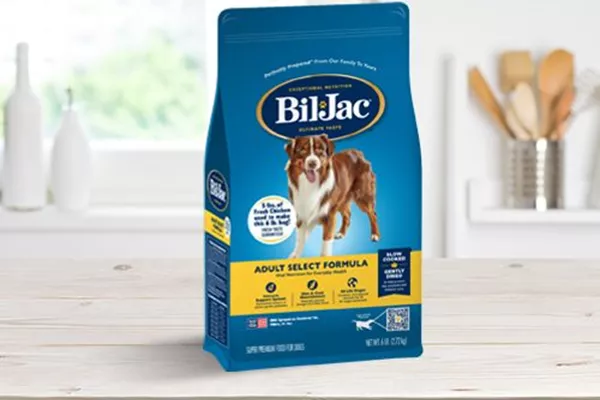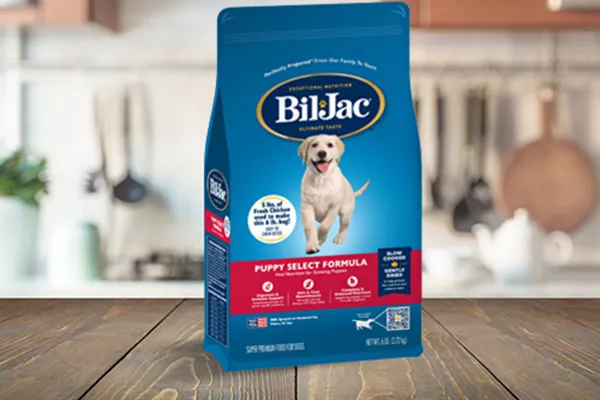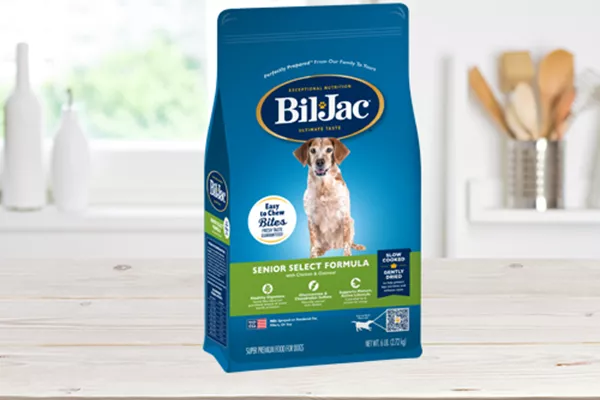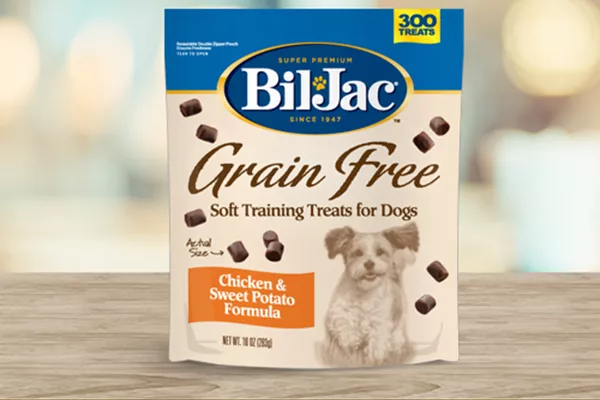All dogs deserve the best quality food, but it’s not always easy for pet parents to pick the right products for their pooch. There are countless dog foods available, and it can take a little research to figure out which one best fits your dog’s needs.
The good news is that each dog food label gives you all the information you need to make the all-important choice of what to feed them. This article will explain the different items you’ll find on a dog food label and what they mean for you and your furry friend.
Mandatory Details for Dog Food Labels (and What They Mean)
While dog food labels differ from product to product, they are required to include certain information for pet parents. There are seven elements that every dog food label should include according to the Association of American Food Control Officials (AAFCO), and each of them can give you information about that product.
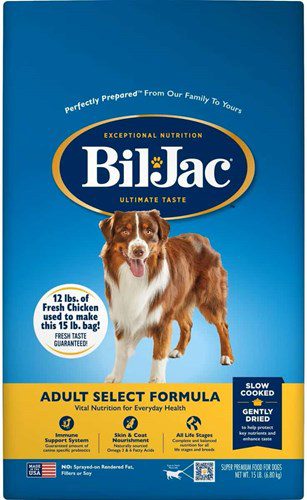
Brand and Product Name
These names work in tandem to let you know the identity of the product. The brand name tells you which company makes the dog food in question, while the product name is the specific dog food being sold. For example, Bil-Jac is the brand name listed on our dog food, while Adult Select Formula is a product name.
While the brand name is straightforward, the product name provides additional information about its contents. AAFCO has specific guidelines for how companies name their product to prevent them from misleading pet parents. These rules can give you more insight into the contents of a particular dog food.
95% Rule
- The technical explanation: Ingredients that are directly in a product name must make up at least 70% of the dog food including added water for processing, and 95% of the food when not including water.
- What that means: The product is made with a majority of the ingredients included in the product name.
- Example product names: “Chicken and Rice Dog Food” and “Chicken for Dogs”
25% Rule
- The technical explanation: Ingredients used in combination with a descriptive term, such as dinner or entrée, must make up at least 10% of the dog food including added water, and 25% when water is not included.
- What that means: The ingredient mentioned is the most notable part of the dog food, but the product contains other ingredients.
- Example product names: “Beef Dinner,” “Chicken Entrée,” “Salmon and Rice Platter”
“With” Rule
- The technical explanation: Dog food that uses the word “with” in the product name must include at least 3% of any named ingredients.
- What that means: Products that follow this rule contain at least 3% of these ingredients.
- Example product name: “Dog Food with Chicken”
“Flavor” Rule
- The technical explanation: A dog food that lists a product as being “flavored with” an ingredient doesn’t need to hit a specific percentage requirement.
- What that means: A small amount of the ingredient is present in the product and is used for taste.
- Example product names: “Chicken-Flavored Dog Food” and “Dog Food Flavored with Beef”
Quantity Statement
This statement lets you know how much dog food is in a product. This total is typically measured by weight and listed on the front of the package so that it’s easy to find. Checking quantities can let you compare different products to know just how much dog food you’re getting with your purchase.
Guaranteed Analysis
This panel on the dog food tells you about the nutrient contents within the product. Dog food should provide your best friend with proper nutrition to help them grow. The guaranteed analysis breaks down the levels of protein, fat, and other nutrients in each product. These nutrients are usually measured by percentages to give you a better understanding of the amount your dog is getting whenever they have a bowl of that specific dog food.
Ingredients List
If you want to know exactly what your dog is eating, you can read the ingredient list for everything included in that specific product. While a long list of different ingredients can be intimidating at first, there are a few basics that can help you more easily understand them.
- The first few ingredients on the list are the ones that are most prominent in that particular dog food. Ingredients must be listed in order of weight, so you’ll be able to tell if there’s more of one ingredient than another.
- By-products are a common dog food ingredient that may sound unappetizing to you, but not your dog. For example, organ meat is a by-product that provides more animal protein and essential nutrients to support your dog’s health.
- While some ingredients will have easily recognizable names, others don’t. It’s very common for there to be long, hard-to-pronounce names that you need to look up online but are completely normal ingredients. For example, DL-Methionine and L-Lysine are the names of essential amino acids that support vital functions for your dog.
- Some ingredients may include a quick description of the ingredient in parentheses. This description can let you know what the ingredient provides or clarifies what it is, such as something being a source of Vitamin C.
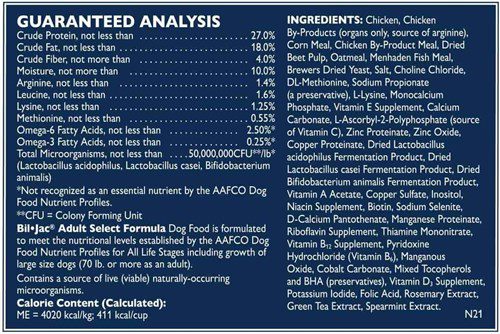
Nutritional Adequacy Statement
While some dog food companies may say that their product is good for your furry four-legged best friend, this section can let you know if what they say is more than just words. The nutritional adequacy statement tells you who the food is appropriate for and if it meets the nutritional standards set by AAFCO. If a label is missing this info, it may not have everything your dog needs to thrive.
Feeding Recommendations
The feeding recommendations give you general guidelines on how much food you should give your furry friend and how often to feed them. These recommendations are typically presented in a chart that will tell you how many cups of food to use each day based on your dog’s weight. The recommendations may also provide other relevant information, such as separate instructions for puppies if it’s a label for an all life stages dog food.
While these recommendations are helpful, it’s important to remember that they aren’t set rules. Every dog is different. Remember to adjust how much food you give your dog to suit their specific needs. If you’re still not sure what’s best, contact your vet to figure out what’s right for your canine companion.
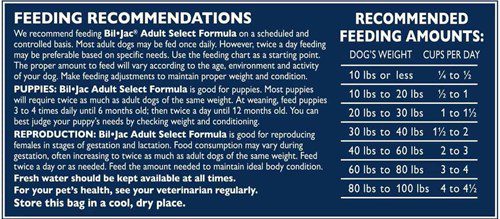
Manufacturer and Distributor
While you might assume that the brand name featured on the label makes that dog food, that’s not always the case. Dog food labels are required to list the name and address of the company that distributes and manufactures that product. This section can let you know where that dog food is manufactured, and what company makes the product.
Common Descriptive Terms on Dog Food Labels
Dog food companies can and will put optional information on their labels, and often use terms to highlight some of the benefits of their product. These different descriptions can give you important insight into whether that product is right for your dog.
Complete and balanced
Dog food must meet special AAFCO regulations to be labeled as “complete and balanced,” “100% nutritious,” or other similar terms. There are more than 40 essential nutrients that pets require for sole source nutrition. AAFCO sets levels for each nutrient, so that you know the dog food you’re considering is made to provide proper nutrition for your dog’s specific stage in life.
All-life stages
While some dog foods are made specifically for puppies, adult dogs, or senior dogs, all-life stages dog foods are formulated to support your furry friend throughout the years. These products must meet the AAFCO’s nutrient requirements for both growth and adult maintenance, which will be referenced in the nutritional adequacy statement.
Lite/reduced calories or fat
Brands that label their products this way should significantly cut either calories or fat and be able to back up that claim. AAFCO requires labels to compare products to make the difference clear to consumers. For example, Bil-Jac Reduced Fat Formula notes that it has 30% less fat than the Adult Select Formula.
Grain-free
A dog food that is labeled as grain-free means that it doesn’t include any wheat, soy, corn, rice, oats, barley, or other types of grains. This description isn’t paired with a seal or some other visual indicator, but you can always check the dog food’s ingredients to know exactly what is in that product.
Slow-cooked
Dog food is made in different ways, with extrusion being the most common method. This process is popular because it’s a quick way to mass produce their product – at the expense of nutrition. If a label says its dog food is slow-cooked, it’s a sign that the food was cooked slowly at lower temperatures, offering a few benefits.
- The protection of key nutrients found in the raw ingredients.
- The ability to use more fresh protein instead of relying on more rendered dry meals.
- A final product that is easier to digest.
Supporting Your Dog, One Label at a Time
Mealtime matters for your dog, and each dog food label can help you identify whether that product is right or wrong for your best friend. Hopefully these tips can help you find a dog food that supports your dog’s needs.
Want to learn more about how you can help your furry friend stay happy, healthy, and well fed? Sign up for the Best Friends Club for more educational articles, special tips, and members-only discounts on Bil-Jac treats and other products.

